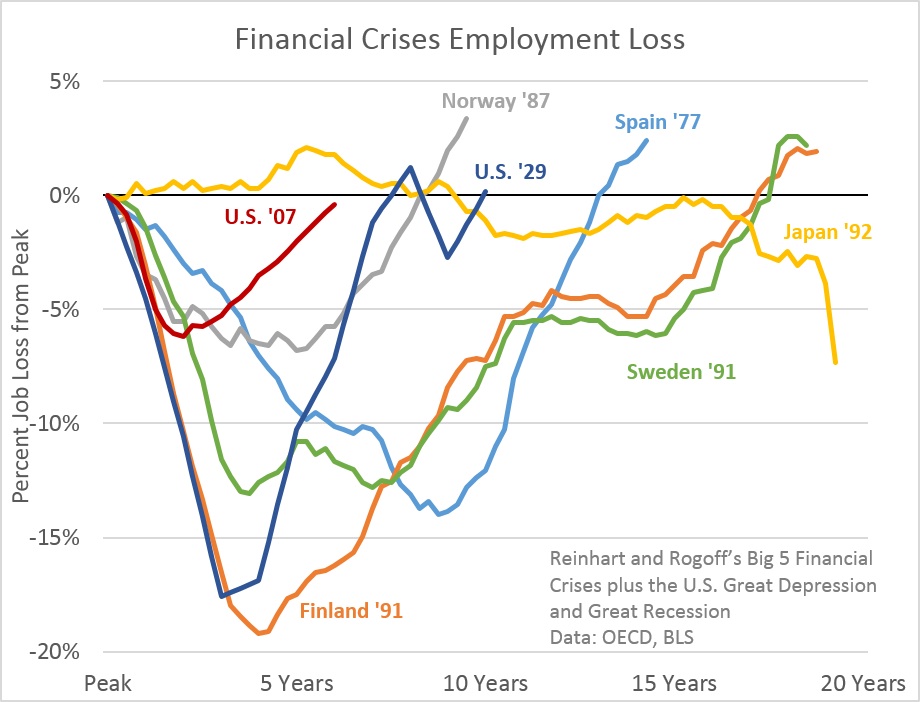March Jobs Report: Good, Not Great
After disappointing, weather-related readings over the past few months, the Labor Department said the economy added 192,000 non-farm jobs in March, a return to the pre-polar-vortex trend. Revisions to the previous two months amounted to an additional 37,000 jobs. The unemployment rate remained at 6.7 percent, which is basically where it has been for the past four months. This good, not great report brings us back to where we were before the severe winter and also helped the economy reach a milestone: private employment has returned to the pre-recession peak and is now at an all time high. However total payroll employment is still 437,000 positions below the pre-recession peak due to government layoffs. Given the current pace of job creation, total employment should reach a new high sometime this summer - a full five years AFTER the recession officially ended. Even that milestone might be a little empty, because we are shooting to go above the December 2007 levels to account for the additional 2 million people who have entered the labor since then.
There is also a big concern that many of the jobs being created are low wage positions. Earlier in the week, the Labor Department released a less talked about analysis of the types of jobs that Americans hold and the wages associated with those jobs. Retail salespeople and cashiers are the nation’s two largest occupations with 4.5 million and 3.3 million respectively, with an average pay of $12.20 and $9.82 per hour respectively. That’s well below the mean for all occupations, which is $22.33/hour or over $46,000 annually.
According to the Wall Street Journal, “During the recession, 60% of job losses occurred in middle-wage occupations paying between $13.83 and $21.13 per hour, while 21% of losses involved jobs paying less than $13.83 hourly. During the recovery, however, only 22% of new jobs paid middle wages while fully 58% were at the lower-wage end of the scale. In other words, millions of re-employed workers have experienced downward mobility.”
In fact, of the 10 largest occupations (retail salespersons, cashiers, food preparation and serving workers, general office clerks, registered nurses, waiters and waitresses; and customer service representatives), which accounted for 21 percent of total employment last year, only registered nurses, who earn about $69,000 had an average wage above the mean. The large numbers of low wage positions also explains why are up only 2.1 percent from a year ago. When adjusted for inflation that is a less than 1 percent rise, which may be part of the reason that the recovery has been sluggish.
Another view is that the recovery has not been bad and in fact, when compared to other recessions that were accompanied by a financial crisis, this recovery is actually a pretty good one. According to the Oregon Office of Economic Analysis, "In terms of employment, the U.S. has actually done fairly well when compared with these other, major crises. Not good enough overall to avoid mass unemployment and lackluster growth, but in the context of historical financial crises, the U.S. employment picture is better than most.” The chart below compares employment loss for Carmen Reinhart and Ken Rogoff’s so-called Big 5 financial crises with the U.S. Great Depression and Great Recession.
If you don’t have a job, it’s meaningless to learn that relative to the other awful times when people were unemployed, this time is actually better. But from a long-term economic perspective, maybe everyone was expecting a bit too much from the recovery, based on how bad the Great Recession and the near-financial crisis were. That’s why it may this jobs report really was good, but just not great.
MARKETS: Did anyone notice that the NASDAQ has been rolling over lately? Since touching its 14-year high on March 6th, the tech-heavy index is down 5.6 percent. The once-high flying Internet index is down 14.5 percent from its March 6 peak, though still remains up 41.6 percent from a year ago and the Biotech Index is off 17.4 percent from its February 25 high, but is also up 41 percent from a year ago. The money from these momentum stocks has not left the market yet, but is rotating to more defensive value-oriented companies, which is why the Dow and S&P 500 continue to flirt with new all-time highs.
- DJIA: 16,412, up 0.6% on week, down 1% YTD
- S&P 500: 1865, up 0.4% on week, up 0.9% YTD
- NASDAQ: 4127, down 0.7% on week, down 1.2% YTD
- 10-Year Treasury yield: 2.73% (from 2.75% a week ago)
- April Crude Oil: $101.14, down 0.5% on week
- June Gold: $1303.50, up 0.7% on week
- AAA Nat'l average price for gallon of regular Gas: $3.57 (from $3.63 a year ago)
THE WEEK AHEAD: Just like clockwork, here comes another round of corporate earnings. Most analysts believe that the bad weather hurt profitability.
Mon 4/7:
3:00 Consumer Credit
Tues 4/8:
Alcoa
7:30 NFIB Small Business Optimism Index
10:00 Job Openings and Labor Turnover Survey (JOLTS)
Weds 4/9:
2:00 FOMC Minutes
Thurs 4/10:
Chain Store Sales
8:30 Weekly Jobless Claims
8:30 Import/Export Prices
Fri 4/11:
JP Morgan Chase, Wells Fargo
8:30 Producer Price Index
9:55 Consumer Sentiment
Photo credit: www.LendingMemo.com


